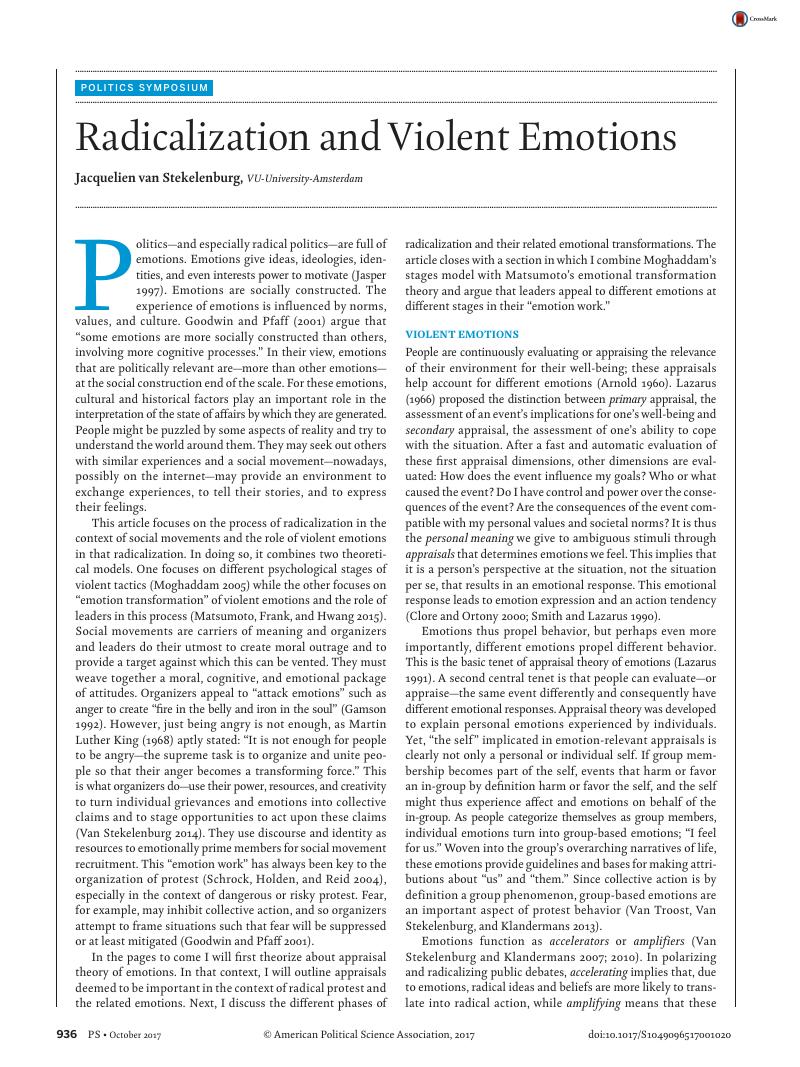Crossref Citations
This article has been cited by the following publications. This list is generated based on data provided by Crossref.
Araque, Oscar
and
Iglesias, Carlos A.
2020.
An Approach for Radicalization Detection Based on Emotion Signals and Semantic Similarity.
IEEE Access,
Vol. 8,
Issue. ,
p.
17877.
Koehler, Daniel
2020.
Violent extremism, mental health and substance abuse among adolescents: towards a trauma psychological perspective on violent radicalization and deradicalization.
The Journal of Forensic Psychiatry & Psychology,
Vol. 31,
Issue. 3,
p.
455.
Haq, Hina
Shaheed, Saad
and
Stephan, Achim
2020.
Radicalization Through the Lens of Situated Affectivity.
Frontiers in Psychology,
Vol. 11,
Issue. ,
de Graaf, Beatrice A
and
van den Bos, Kees
2021.
Religious radicalization: social appraisals and finding radical redemption in extreme beliefs.
Current Opinion in Psychology,
Vol. 40,
Issue. ,
p.
56.
Rolling, Julie
Corduan, Guillaume
Roth, Martin
Schroder, Carmen M.
and
Mengin, Amaury C.
2022.
Violent Radicalization and Post-traumatic Dissociation: Clinical Case of a Young Adolescent Girl Radicalized.
Frontiers in Psychiatry,
Vol. 13,
Issue. ,
Poppi, Fabio Indìo Massimo
2022.
Fiat panis: identity representation and identity change in food narratives.
Consumption Markets & Culture,
Vol. 25,
Issue. 5,
p.
429.
Lavenne-Collot, Nathalie
Dissaux, Nolwenn
Campelo, Nicolas
Villalon, Charlotte
Bronsard, Guillaume
Botbol, Michel
and
Cohen, David
2022.
Sympathy-Empathy and the Radicalization of Young People.
Children,
Vol. 9,
Issue. 12,
p.
1889.
Reinke de Buitrago, Sybille
2022.
Radikalisierungsnarrative online.
p.
1.
Medel, Rodrigo M.
Asún, Rodrigo A.
and
Zúñiga, Claudia
2022.
Why do people engage in violent tactics during a protest campaign? Understanding radical activist through regionalist mobilizations in Chile.
Social Science Quarterly,
Vol. 103,
Issue. 5,
p.
1061.
Rashid, Lubna
2022.
Bursting the bubble: why sustainability initiatives often lack adequate intention to action translation.
Small Business Economics,
Vol. 59,
Issue. 1,
p.
1.
Solovev, Kirill
and
Pröllochs, Nicolas
2022.
Moral Emotions Shape the Virality of COVID-19 Misinformation on Social Media.
p.
3706.
Clément, Maéva
2023.
Radicalization and Variations of Violence.
p.
15.
Sevelsted, Anders
and
Toubøl, Jonas
2023.
The Power of Morality in Movements.
p.
15.
Benevento, Ayşenur
2023.
The Necessity to Recognize Processes of Radicalization from a Socio-cultural Perspective.
Integrative Psychological and Behavioral Science,
Vol. 57,
Issue. 4,
p.
1418.
Mantello, Peter
Ho, Tung Manh
and
Podoletz, Lena
2023.
The Palgrave Handbook of Malicious Use of AI and Psychological Security.
p.
81.
Shafieioun, Delaram
and
Haq, Hina
2023.
Radicalization from a societal perspective.
Frontiers in Psychology,
Vol. 14,
Issue. ,
Pavlović, Tomislav
and
Franc, Renata
2023.
Antiheroes fueled by injustice: dark personality traits and perceived group relative deprivation in the prediction of violent extremism.
Behavioral Sciences of Terrorism and Political Aggression,
Vol. 15,
Issue. 3,
p.
277.
Moncrieff, Michael
and
Lienard, Pierre
2023.
Radicalization and violent extremism depend on envy; conspiracy ideation, sometimes.
Frontiers in Psychology,
Vol. 14,
Issue. ,
Zhu, Alex Yue Feng
and
Chou, Kee Lee
2023.
Situational appraisal and emotional responses of the public in the social movement.
Current Psychology,
Vol. 42,
Issue. 15,
p.
12387.
Real, Patricia Alonso Del
and
Araque, Oscar
2023.
Contextualization of a Radical Language Detection System Through Moral Values and Emotions.
IEEE Access,
Vol. 11,
Issue. ,
p.
119634.



